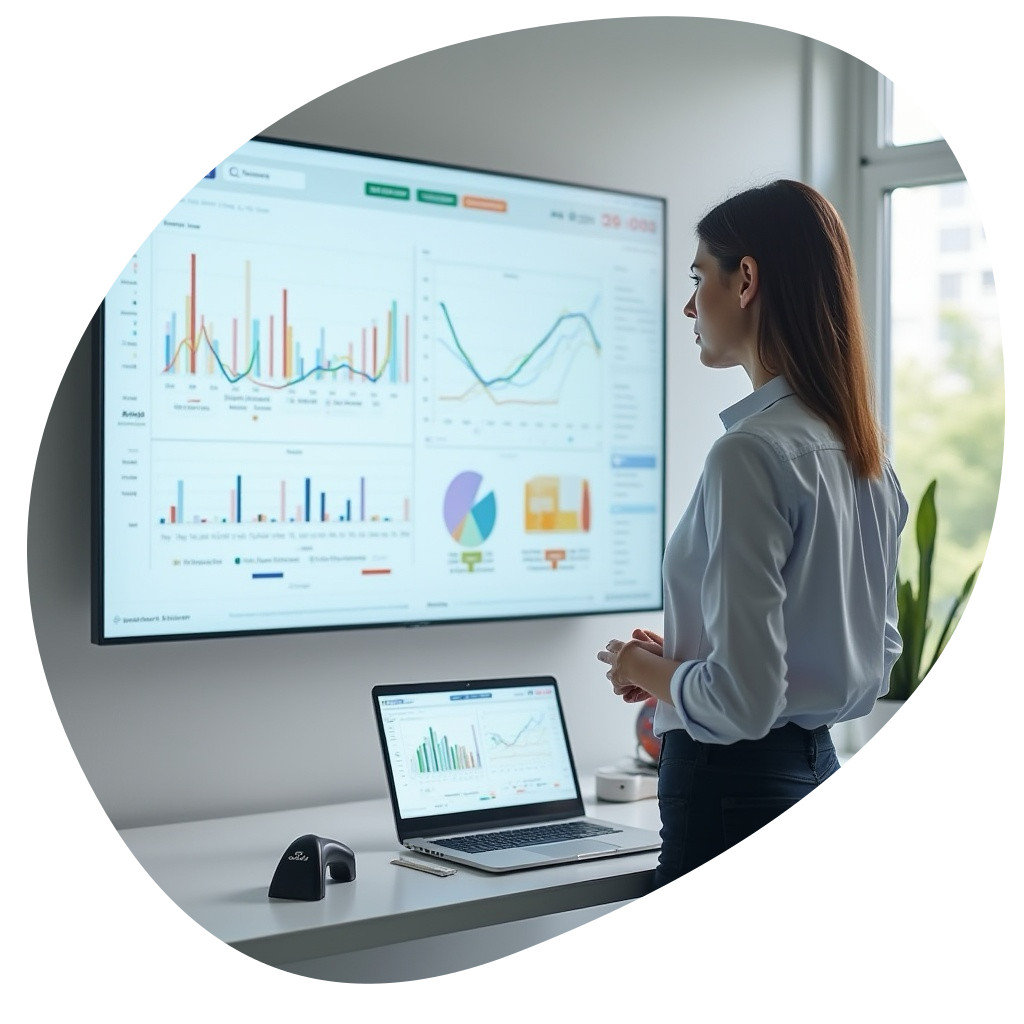Demand Planner: What the Role Is, Skills & Software Tools


The Strategic Role of a Demand Planner in Modern Supply Chains
For growing online sellers, the difference between profit and loss often hinges on inventory precision – having the right products in the right places at the right time. This balance is the domain of the demand planner, a pivotal position that drives service levels across omnichannel retail environments.
A demand planner analyzes historical data, market trends, and business intelligence to forecast future inventory needs accurately. By connecting sales, operations, and finance, these professionals ensure optimal stock levels while preventing costly stockouts.
This guide explores every aspect of demand planning – from core responsibilities to technology tools and performance metrics. We'll examine how demand planners collaborate within S&OP processes, navigate eCommerce challenges, and build rewarding careers. For deeper insights into planning methodologies, explore our inventory planning software guide.
Throughout, we'll highlight how Finale Inventory empowers demand planners to transform inventory into a strategic advantage.
Where the Demand Planner Fits in a Multichannel Supply Chain
The demand planner serves as the crucial link between inventory forecasting and fulfillment across sales channels. Unlike buyers who focus on procurement or supply managers who handle vendor relationships, demand planners take a holistic approach to inventory allocation.
Key Responsibilities
The primary objective of this role is balancing stock levels across FBA, 3PL warehouses, retail locations, and wholesale channels while protecting cash flow. This balancing act requires analytical precision to ensure product availability without excessive capital investment.
A demand planner regularly collaborates with:
- Marketing teams on promotional inventory needs
- Finance departments on cash flow planning
- Warehouse operations on shipment scheduling
- Customer service on product availability issues
You'll find this position advertised as supply chain demand planner, demand and inventory planner, or eCommerce analyst, reflecting its cross-functional nature in modern operations.
Effective demand planning requires consolidated data from all channels, which explains why businesses implement inventory planning software that unifies information from multiple systems. Without this unified view, accurately forecasting demand or optimizing safety stock levels becomes significantly more challenging.
Collaboration & S&OP: Demand Planner vs Supply Planner
The distinction between demand planning and supply planning represents a critical divide in inventory management. A demand planner forecasts what customers will purchase, while a supply planner ensures those products are available through procurement and production.
In smaller businesses, you'll often find a demand supply planner wearing both hats. This hybrid role bridges forecasting with execution, requiring skills in both predictive analytics and vendor management.
The S&OP Rhythm
Sales and Operations Planning (S&OP) provides the framework where demand and supply professionals collaborate. A typical S&OP cycle includes:
- Demand review (Week 1): Marketing and sales present forecasts
- Supply review (Week 2): Supply team evaluates capacity constraints
- Pre-executive meeting (Week 3): Cross-functional teams resolve misalignments
- Executive S&OP (Week 4): Leadership approves final plans
Communication best practices include using shared metrics rather than departmental KPIs, documenting forecast assumptions, and maintaining a "single source of truth" through integrated inventory planning software.
When demand and supply teams communicate effectively, they prevent the bullwhip effect and transform from competing interests into partners working toward optimal inventory levels.
What Does a Demand Planner Do?
A demand planner's role centers around forecasting product needs and ensuring optimal inventory levels. Their daily and weekly activities form the backbone of effective inventory management for growing businesses.
Core Daily Activities
- Data gathering and analysis: Collecting point-of-sale data, historical sales patterns, and market intelligence to build accurate forecasts
- Forecast monitoring and adjustment: Identifying deviations from predicted demand and making real-time corrections
- Exception reporting: Flagging anomalies that require immediate attention (stockouts, sudden demand spikes)
- Cross-departmental communication: Sharing insights with sales, marketing, and operations teams
Demand planners drive inventory optimization software implementation by establishing proper reorder points and safety stock levels. They evaluate when to trigger replenishment based on lead times and determine optimal order quantities to balance carrying costs against volume discounts.
For product launches and promotions, demand planners create specialized forecasts that account for marketing activities, seasonality, and cannibalization effects on existing products. This prevents both stockouts during high-demand periods and excess inventory after promotions end.
In e-commerce operations, particularly those using Fulfillment by Amazon, demand planners develop cross-dock strategies and transfer recommendations to navigate inventory restrictions while maintaining sufficient stock levels across all channels.
While spreadsheets can handle basic demand planner responsibilities, they quickly become inadequate as businesses scale. The complexity of managing hundreds or thousands of SKUs across multiple locations requires specialized tools that can process large datasets, incorporate machine learning, and automate routine calculations—capabilities beyond what manual forecasting in Excel can provide.
Critical Skills & Competencies for a High-Impact Demand Planner Role
The transition from tactical forecasting to strategic demand planner role requires mastering several key competencies that elevate the position from data partner to business partner.
Analytical Excellence
Effective demand planners interpret complex patterns in sales velocity, distinguish between trends and noise, and quantify seasonality impacts. This analytical thinking transforms data into actionable intelligence.
Technical Proficiency
Demand planner skills must include:
- Advanced Excel modeling for scenario planning
- Basic SQL knowledge for data extraction
- Dashboard development to visualize forecasts
- Experience with demand forecasting models
Cross-Functional Communication
Soft skills differentiate exceptional planners. The ability to influence without authority, facilitate meetings, and negotiate consensus between departments becomes critical when forecasts impact the entire organization.
Industry Knowledge
Understanding supply chain realities—like lead times, transportation constraints, and inventory aging report implications—contextualizes forecasts within operational limits. For ecommerce businesses, knowledge of marketplace policies directly impacts planning effectiveness.
Strategic Vision
What gives demand planner meaning is connecting forecasts to business outcomes. With proper mentoring, planners evolve from "forecast clerks" into strategic partners who shape decisions rather than simply reporting them.
Technology Stack: From Excel to Cloud Demand Planner Software
The demand planning technology landscape has evolved dramatically, giving businesses more options than ever for forecasting and inventory management. Understanding this progression helps contextualize which demand planner software best fits your business needs.
The Evolution of Demand Planning Tools
Most businesses begin their demand planning journey with Excel spreadsheets—a versatile starting point for basic forecasting. While Excel offers flexibility, it often becomes unwieldy as businesses scale. The next evolution typically involves BI plug-ins that enhance Excel's capabilities with visualization.
Today's cloud-based demand planner tools represent the current pinnacle, offering real-time processing and integration capabilities that stand-alone spreadsheets cannot match.
Essential Features for SMB Sellers
For small to medium businesses, certain features are non-negotiable:
- Real-time channel synchronization that pulls sales data from all platforms
- Open API architecture allowing custom connections to existing systems
- Barcode-driven operations that eliminate manual data entry errors
- User-friendly dashboards that don't require a data science degree
While AI and machine learning generate buzz, most SMBs achieve excellent results with proven velocity-based methods and moving-average calculations.
Quick-Start Evaluation Checklist
When assessing potential platforms:
- Confirm data import capabilities match your sales channels
- Verify the system handles your inventory turnover ratio calculation methodology
- Test the software with your historical data before committing
For more comprehensive evaluation criteria, our inventory planning software guide offers a complete framework, including safety stock and abc analysis formulas.
Measuring Impact: KPIs Every Demand and Supply Planner Tracks
Tracking the right metrics provides the compass that guides effective inventory management. Four essential KPIs stand out for every demand and supply planner:
Forecast accuracy measures the percentage difference between predicted and actual demand. Aim for at least 80% accuracy for stable products, with more flexibility for seasonal items.
Service level reflects your ability to fulfill customer orders completely and on time. Most businesses target 95-98% to balance satisfaction with inventory costs.
Inventory turns indicate how efficiently capital is working for you. Higher turns mean better cash flow, with most retailers targeting 4-12 turns annually.
GMROI (Gross Margin Return on Investment) connects inventory directly to profitability, revealing which products generate the most profit per dollar invested.
For effective dashboard cadence, supply chain demand planners should implement weekly operational reviews and monthly executive summaries. When presenting to leadership, tie these metrics directly to cash flow targets and growth objectives.
For deeper analysis, periodically examine your reorder point formula calculations at the SKU level. Consider using inventory planning software that automates reporting and provides actionable insights across your entire product catalog.
eCommerce-Specific Challenges & How a Demand and Inventory Planner Solves Them
The eCommerce landscape presents unique inventory challenges that demand specialized approaches. Unlike traditional retail, online sellers face obstacles that quickly impact profitability.
Amazon FBA Complexities
Amazon FBA sellers navigate constantly changing restock limits. A skilled demand and inventory planner must balance these restrictions against stockout risks. Aged-inventory fees erode margins when products linger, requiring proactive aging analysis and pricing adjustments.
Unpredictable Demand Patterns
Digital marketplaces introduce extreme volatility. Flash sales can deplete weeks of inventory in hours, while influencer mentions create sudden demand surges without warning. These events require dynamic buffer calculations and rapid vendor communication protocols.
SKU Management Challenges
Online catalogs expand rapidly, leading to SKU proliferation and cannibalization when similar items compete for the same customer dollars. Inventory optimization software becomes essential for data-driven assortment decisions.
What does a demand planner do in this environment extends beyond basic forecasting to implementing inter-warehouse transfers, promotion overlay models, and channel-specific safety stock calculations. The multichannel pressure transforms the planner's role from reactive to proactive, requiring sophisticated analytical approaches to succeed in this dynamic environment.
Career Path, Qualifications & Compensation for Modern Demand Planners
Breaking into the demand planner role typically requires specific educational backgrounds and certifications. Most professionals hold bachelor's degrees in Supply Chain Management, Business Analytics, or Operations Research. Industry certifications provide crucial validation of specialized skills.
APICS CPIM (Certified in Production and Inventory Management) and IBF (Institute of Business Forecasting) certifications are highly valued credentials that demonstrate expertise in inventory control and forecasting methodologies. Advanced Excel skills and experience with statistical analysis are also essential.
Demand planning professionals command competitive salaries:
- Entry-level (0-2 years): $55,000-$70,000
- Mid-level (3-5 years): $70,000-$95,000
- Senior-level (6+ years): $95,000-$125,000+
eCommerce specialists typically earn 10-15% more due to multichannel inventory complexities.
The demand planner meaning extends beyond tactical forecasting into strategic business growth. Career advancement often leads to roles such as Planning Manager, Director of Operations, or VP Supply Chain. As businesses recognize inventory optimization as a competitive advantage, demand planners with proven track records become indispensable to leadership teams.
First 90 Days: Setting Up a Scalable Demand Supply Planner Function
Transitioning from understanding the demand planner role to implementation requires focused execution. Begin with SKU master rationalization – clean up duplicates, standardize naming, and create logical hierarchies to ensure accurate forecasting.
Develop a stakeholder map identifying departments impacted by your forecasts, and establish a regular S&OP calendar with clear responsibilities.
Select right-sized demand planner software that balances statistical accuracy with manual override capabilities rather than overly complex solutions. Establish KPIs aligned with business objectives like forecast accuracy and inventory turnover ratio.
Demonstrate value quickly through achievable early wins:
- Developing a backorder recovery plan
- Creating efficient FBA inventory transfer schedules
- Establishing a basic statistical forecast baseline
These quick wins build credibility while laying the foundation for sustainable demand planning excellence and safety stock optimization.
Empowering Demand Planners With Finale Inventory's Proven Planning Layer
Finale Inventory offers a cloud-native platform specifically designed for small-to-mid-market multichannel sellers who struggle with inventory visibility and planning challenges. Unlike complex enterprise systems, Finale targets businesses with annual revenues between $2M-$200M that manage 200-50,000 SKUs across multiple locations.
Real-Time Visibility Across All Channels
For the demand planner role, Finale provides a consolidated dashboard that brings together inventory data from every selling channel and warehouse location. This unified view eliminates the information gaps that often plague multichannel operations.
"This software has allowed us to stay organized with our inventory, know exactly when orders need to be placed for each of our brands, keep track of out-of-stock or back-ordered products, place purchase orders, and so much more." – Stephanie Parks, CEO @ DermWarehouse
The platform employs traditional velocity-based forecasting and moving-average methods rather than making exaggerated AI promises. This practical approach aligns perfectly with the day-to-day needs of a supply chain demand planner who needs reliable, transparent data rather than black-box predictions.
From Forecast to Action in Seconds
Finale converts forecasts into actionable purchase orders and warehouse transfers automatically, addressing a key pain point for planning teams. This functionality eliminates the spreadsheet fatigue that plagues so many operations departments.
"When you take the time to really set up Finale with all of your product information and reorder points tightly, it makes every day work a breeze!" – Heath C., Inventory Manager
The system incorporates dynamic safety stock calculations and configurable reorder points, implementing the core concepts discussed in inventory planning software. These settings can be customized by SKU, category, or supplier to match your specific business rules and lead time considerations.
Accuracy Through Barcode Integration
For the demand and inventory planner fighting Amazon chargebacks and listing errors, Finale's mobile barcode scanning capabilities ensure execution accuracy at every step:
- Guided receiving workflows verify incoming shipments against POs
- Barcode-driven transfers ensure the right products move between locations
- Cycle counting tools maintain perpetual inventory accuracy
- FBA prep functions produce compliant labels and packaging
"It's allowed us to become way better about keeping inventory in stock, made purchasing in time from overseas much easier. It's virtually eliminated shipping errors." – Brett Haney, President @ Microfiber Wholesale
Easy Integration Without IT Overhead
Finale's open API and native QuickBooks sync capability allow teams to layer powerful planning functionality on top of existing systems without an ERP overhaul. This makes it ideal for growing businesses that need better planning tools without disrupting current operations.
The platform's implementation timeline aligns perfectly with the 90-day roadmap many demand planners work within when implementing new processes. Most customers can be up and running within weeks rather than months.
Measurable Business Outcomes
Companies using Finale typically report significant improvements in key performance indicators:
- 15-30% reduction in overall inventory value through right-sizing stock levels
- 90% decrease in time spent generating purchase orders
- Near-elimination of stock-outs for top-selling products
- Improved inventory turnover as excess inventory is identified and addressed
- Reduced warehouse errors through barcode verification
By providing the tools needed for effective demand forecasting models without unnecessary complexity, Finale helps planning teams focus on strategic decisions rather than data collection and manipulation.
Conclusion
A skilled demand planner transforms data into profit for fast-growing eCommerce brands. By bridging analytics with business strategy, these professionals create forecasts that minimize both stockouts and excess inventory situations.
Throughout this guide, we've examined the essential elements of effective demand planning: clear role definition, cross-functional collaboration, meaningful KPIs, strategic tool selection, and career growth opportunities. The most successful planners balance analytical rigor with operational practicality.
Remember that accuracy and cash efficiency don't require artificial intelligence. Even without the latest AI solutions, proven methodologies paired with the right demand planner tools consistently deliver superior inventory optimization outcomes.
As your business outgrows spreadsheets, consider how structured inventory planning software can transform your forecasting capabilities. The best systems integrate seamlessly with your existing workflows while providing the visibility needed for confident decision-making.
When you're ready to upgrade your planning capabilities, Finale Inventory offers the comprehensive solution that growing multi-channel businesses need to scale with confidence.
Frequently Asked Questions
A demand planner predicts future product demand by analyzing historical data, market trends, and business intelligence. They create statistical forecasts, collaborate with sales and marketing teams to incorporate promotional activities, and work with supply chain teams to ensure inventory availability meets projected demand. Demand planners maintain forecast accuracy metrics, identify demand patterns, and communicate insights across departments. They're the crucial link between customer demand and inventory planning, ensuring companies have the right products available at the right time without excess stock tying up capital.
Demand planner salaries vary based on experience, industry, company size, and location. Entry-level positions typically start around $60,000-$70,000 annually, while mid-career professionals with 3-5 years of experience can earn $75,000-$90,000. Senior demand planners with specialized skills in AI forecasting tools and proven forecast accuracy improvements often command $95,000-$120,000+. Fast-growing ecommerce companies and multichannel retailers frequently offer competitive compensation to attract talent who can optimize inventory across complex distribution networks while maintaining high service levels.
Most demand planners have a bachelor's degree in supply chain management, business analytics, operations, or a related field. Essential qualifications include strong analytical skills, proficiency with Excel and forecasting software, statistical knowledge, and understanding of inventory management principles. Experience with inventory planning software is increasingly valuable. Successful planners combine technical abilities with interpersonal skills to collaborate across departments. Many professionals earn certifications like APICS CPIM or IBF's Certified Professional Forecaster to demonstrate expertise. For ecommerce specialists, familiarity with multichannel fulfillment and marketplace dynamics is particularly advantageous.
The primary objective of a demand planner is to create accurate forecasts that balance inventory investment with customer service levels. They aim to minimize both stockouts and excess inventory by predicting future demand patterns across products, channels, and regions. Demand planners work to reduce the bullwhip effect in supply chains by providing stable, reliable forecasts that prevent unnecessary production and inventory fluctuations. Their goal is to support efficient operations while meeting customer expectations for product availability—ultimately improving cash flow, reducing costs, and maximizing revenue opportunities through optimal inventory positioning.
The demand planner role has transformed dramatically, shifting from spreadsheet-focused forecasting to leveraging AI inventory management tools that analyze vast datasets. Today's planners incorporate real-time data from multiple channels, including marketplace analytics and social media signals. They're increasingly responsible for scenario planning to address supply chain disruptions and demand volatility. The role now requires greater cross-functional collaboration and technology proficiency, particularly in cloud-based platforms that connect inventory across locations. For multichannel retailers, demand planners have become strategic advisors who translate consumer behavior into actionable stocking decisions rather than just number crunchers.
Successful demand planners combine analytical expertise with business acumen and communication skills. They need proficiency in statistical forecasting methods, data visualization, and inventory management principles. Understanding product lifecycles, seasonality patterns, and promotional impacts is crucial for accurate planning. Technical skills include mastery of demand planning software, Excel modeling, and increasingly, experience with AI-driven forecasting tools. Strong demand planners also possess exceptional cross-functional communication abilities to gather insights from sales, marketing, and operations teams. Critical thinking and problem-solving skills help identify forecast anomalies and develop mitigation strategies for demand variability.
A demand planner's core responsibilities include developing and maintaining statistical forecasts across products and channels, collaborating with sales and marketing on promotional planning, and analyzing historical data for trends and seasonality. They calculate safety stock requirements and reorder points, participate in Sales and Operations Planning (S&OP) meetings, and generate reports on forecast accuracy. Modern demand planners also manage supply chain optimization software implementations, conduct scenario planning for market changes, and continuously refine forecasting models based on performance metrics. For multichannel retailers, they coordinate inventory positioning across warehouses, FBA, and retail locations to maximize availability.
Demand planners have diverse career advancement opportunities. Many progress to senior demand planning or forecasting manager roles with team leadership responsibilities. Others move into broader supply chain positions like supply planning, inventory management, or S&OP leadership. Some transition to business intelligence or data analytics roles, leveraging their forecasting expertise. As they gain cross-functional experience, demand planners can advance to director-level positions in supply chain or operations. The role also provides excellent preparation for consulting careers or specialized positions in software implementation. For entrepreneurially-minded professionals, demand planning skills are invaluable for launching or scaling ecommerce businesses.
The demand planner role is rapidly evolving toward greater technology integration and strategic influence. Future demand planners will spend less time on manual data manipulation and more on interpreting AI-generated insights from inventory optimization software. They'll increasingly incorporate external data like social media trends, weather patterns, and macroeconomic indicators into forecasts. The role will require stronger change management skills as planning systems become more sophisticated. Demand planners will take on more scenario planning responsibilities to prepare for supply chain disruptions and market shifts. The most successful professionals will combine technical expertise with business strategy skills to translate demand signals into competitive advantage.
Demand planning focuses on forecasting customer requirements and market demand to predict what products will sell and when. Supply planning, conversely, determines how to fulfill that forecasted demand through production scheduling, material sourcing, and inventory positioning. Demand planners analyze historical sales, market trends, and promotional activities to create forecasts, while supply planners work with suppliers, manufacturing, and logistics to ensure product availability. Though distinct, these functions must work in close coordination—demand plans feed directly into supply plans. In smaller organizations, particularly ecommerce businesses, these roles may be combined into a demand-supply planner position that manages both sides of the equation.
Demand planners function as critical cross-functional connectors within organizations. They work with sales teams to incorporate account-specific forecasts and promotional plans; with marketing to understand campaign timing and expected lift; with finance to align forecasts with financial projections; and with operations to ensure feasible production and distribution plans. They participate in regular S&OP meetings where all departments align on a single operational plan. Effective demand planners develop strong relationships across departments, translating technical forecasting concepts into business-relevant insights. This collaboration ensures forecasts reflect both market realities and organizational capabilities while supporting strategic objectives across the business.
Demand planners utilize a range of specialized tools, from basic spreadsheets to sophisticated AI-powered platforms. Many start with Excel for fundamental calculations but progress to dedicated forecasting solutions like Finale Inventory that integrate historical data, statistical models, and collaborative features. Enterprise demand planners often use modules within ERP systems (SAP, Oracle) or specialized applications that connect to their existing systems. The most effective solutions provide visualization capabilities, what-if scenario modeling, and integration with inventory management systems. Cloud-based platforms are increasingly popular for multichannel retailers who need real-time visibility across sales channels and distribution points without extensive IT infrastructure.
Businesses evaluate demand planners through several key performance indicators. Forecast accuracy metrics like MAPE (Mean Absolute Percentage Error) measure prediction precision. Inventory performance indicators include inventory turnover ratio, service levels (fill rates), and inventory obsolescence. Financial impact metrics track working capital improvements, stockout-related revenue loss, and carrying cost reductions. The most comprehensive assessment combines quantitative measures with qualitative evaluation of cross-functional collaboration effectiveness. Leading organizations recognize that top demand planners deliver value beyond basic accuracy—they provide actionable insights that improve overall business performance through better inventory positioning, reduced costs, and enhanced customer satisfaction.
Seamless Inventory planning
Set your inventory up for success with advanced planning software


Get Started with Finale
Our guided implementation during your onboarding will set you on the path to scaled business growth in just two weeks.
Get a demo on the
first call.Pricing is fair and
transparent.Onboarding starts
with a dedicated consultant.
Get a demo on the
first call.Pricing is fair and
transparent.Onboarding starts
with a dedicated consultant.
Your time is valuable. That's why we jump into the software during your first call.
Finale offers competitive pricing because users stay and grow.
Guided implementation during your onboarding to be set for success.





